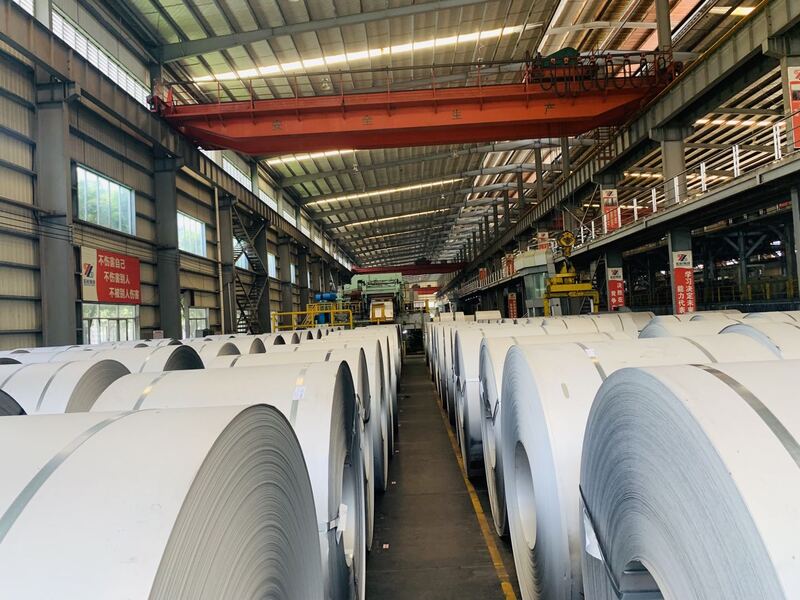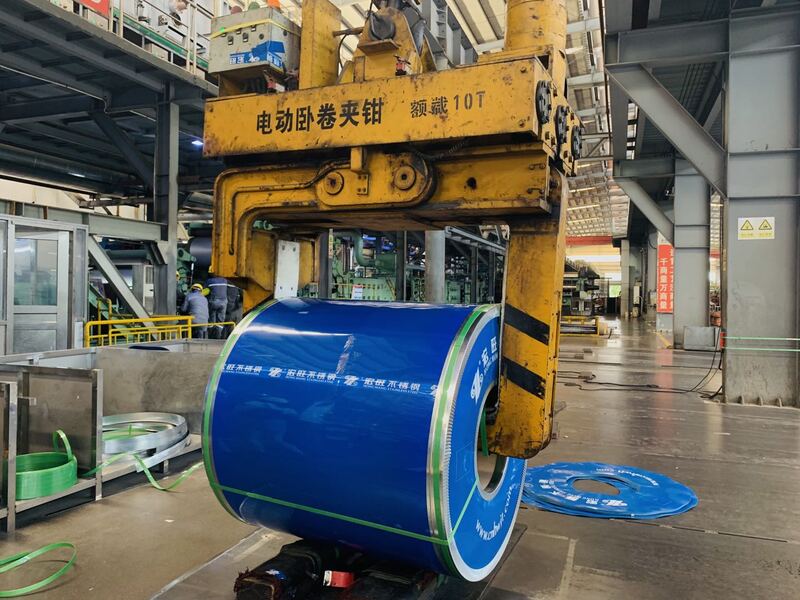
Current Location : Home > News > Industry News > Stainless steel coil plates industry
Stainless steel coil plates industry
Time:2021-09-24
Source:Wuxi Hongwang
Hits:316
The stainless steel coil plates industry has reached an advanced level of development. As long asstainless steel coil plates industry maintains self-discipline and acts rationally, it can cope with the downward pressure of the economy. For the problems and suggestions put forward by enterprises, the steel association will further play the role of a bridge link and platform advantages, and actively promote the relevant work, and enterprises work together to maintain the smooth operation of the industry.
Domestic stainless steel coil plates production continues to maintain a high level, by the automotive, home appliances and other downstream demand growth is slowing and the impact of the intensification of the trade situation, the market supply of strong demand weak features more significant, steel prices show a low level of vibration trend. At the same time, iron ore, coke and other raw fuel prices running at a high level, stainless steel coil plates enterprises face a more severe market operating environment, profitability and efficiency levels fell significantly.
Stainless steel coil plates industry economic operation in the following problems.
1. Stainless steel coil plates production high level of volatility, coupled with a steady slowdown in demand growth, increasing the competitive pressure on enterprises.
2. The intensification of the global trade situation, the adverse impact on exports, but also intensified competition in the domestic market.
3.Environmental restrictions on the production and operation of enterprises still have a greater impact.
4.High fluctuations in the prices of iron ore, coke and other raw fuels increased the pressure on enterprises' operations.
5.There are still problems in the process of implementing policies to reduce taxes and fees, with the tax-inclusive price of electricity for large industries remaining unchanged and logistics costs rising significantly, among other issues to be resolved.
Financial institutions are still more cautious about lending to the real economy, the relative shortage of funds for enterprise development.
1. Two key alloying elements to form stainless steel
Naturally no alloy is formed. Of course some accidents can happen. For example, gold miners occasionally found alloys in the ground where gold and silver could be mixed together, and since then man has learned how to use alloys. Many early societies created cooking utensils and other household items, most of which were made of copper, a soft metal. During the Bronze Age, metalworkers developed a way to make corrosion-resistant alloys that lasted, made from copper mixed with tin, bronze having greater strength and corrosion resistance.
Steel itself is mixed with iron and a small amount of carbon, unfortunately, iron rusts over time as the elements react with carbon in air and water. However, by adding small amounts of nickel and chromium to the molten metal, scientists found that they could form corrosion-resistant alloys that would help prevent the problem of steel being prone to rusting. Since then the invention of "stainless steel" has changed the world.
2. Nickel alloys can make stainless steel more durable
Many Americans are using white metal nickels. Years ago, the US Mint added nickel to produce a stronger, more durable coin. The combination of chromium, nickel and iron helps to shape the steel even more and it resists high temperatures very well.
3. Nickel alloys can be magnetised very quickly
Unlike other metals, nickel can be magnetised very quickly. Therefore, nickel is not only an important component of corrosion-resistant stainless steel alloys, it also plays an important role in many magnets. By mixing nickel, cobalt and iron, manufacturers have created permanent magnet alloys for use in a variety of applications.
4. Chromium requires high temperature solid solution
Chromium alloys require a much higher temperature to melt. Solid chromium will not melt in a furnace unless the temperature reaches 3465 degrees Fahrenheit or higher. Its high-temperature resistance is a very useful requirement for refractory steels and is used successfully in applications such as aircraft and high-speed train engines.
5. Chromium can form a ruby red colour
Many people appreciate the brilliant red colour of rubies. Surprisingly, the chromium ore contained in nature can also form this colour. Chromium alloys not only play a vital role in the corrosion resistance of stainless steel, but their bright colours are combined with other metals in two forms, including yellow, green or red.
The necessary conditions for stress corrosion cracking to occur are the presence of tensile stress (whether residual or applied, or both) and a specific corrosive medium. The formation and expansion of the pattern is approximately perpendicular to the direction of the tensile stress. This stress value, which leads to stress corrosion cracking, is much smaller than that required to fracture the material in the absence of a corrosive medium.
At the microscopic level, the crack through the grain is called a through-grain crack, while the crack along the grain boundary expansion is called an along-grain crack. When the stress corrosion cracking extends to its depth (here, the stress on the section of the loaded material reaches its fracture stress in air), the material is broken by normal cracking (in ductile materials, usually through the aggregation of microscopic defects).
The section of a part that fails due to stress corrosion cracking will therefore contain the characteristic area of stress corrosion cracking and the area of "toughness nests" associated with the aggregation of already microscopic defects.
Tags: stainless steel coil plates,stainless steel coil plates industry,stainless steel coil plates use precautions,stress corrosion cracking of stainless steel coil plates
Domestic stainless steel coil plates production continues to maintain a high level, by the automotive, home appliances and other downstream demand growth is slowing and the impact of the intensification of the trade situation, the market supply of strong demand weak features more significant, steel prices show a low level of vibration trend. At the same time, iron ore, coke and other raw fuel prices running at a high level, stainless steel coil plates enterprises face a more severe market operating environment, profitability and efficiency levels fell significantly.
Stainless steel coil plates industry economic operation in the following problems.
1. Stainless steel coil plates production high level of volatility, coupled with a steady slowdown in demand growth, increasing the competitive pressure on enterprises.
2. The intensification of the global trade situation, the adverse impact on exports, but also intensified competition in the domestic market.
3.Environmental restrictions on the production and operation of enterprises still have a greater impact.
4.High fluctuations in the prices of iron ore, coke and other raw fuels increased the pressure on enterprises' operations.
5.There are still problems in the process of implementing policies to reduce taxes and fees, with the tax-inclusive price of electricity for large industries remaining unchanged and logistics costs rising significantly, among other issues to be resolved.
Financial institutions are still more cautious about lending to the real economy, the relative shortage of funds for enterprise development.

Stainless steel coil plates use precautions
Stainless steel coil plates play a very important role in everyday life. From boats to trains to skyscrapers, some important alloying elements can help stainless steel perform better in a variety of applications. Generally speaking, any mixture of two or more metals is referred to as an "alloy steel". Stainless steel is also an alloyed steel, and some of the metal elements that are important in forming the alloy include: iron, nickel, chromium and cobalt. Corrosion-resistant elements help stainless steel to inhibit the rusting process. The following five elements are key to these substances.1. Two key alloying elements to form stainless steel
Naturally no alloy is formed. Of course some accidents can happen. For example, gold miners occasionally found alloys in the ground where gold and silver could be mixed together, and since then man has learned how to use alloys. Many early societies created cooking utensils and other household items, most of which were made of copper, a soft metal. During the Bronze Age, metalworkers developed a way to make corrosion-resistant alloys that lasted, made from copper mixed with tin, bronze having greater strength and corrosion resistance.
Steel itself is mixed with iron and a small amount of carbon, unfortunately, iron rusts over time as the elements react with carbon in air and water. However, by adding small amounts of nickel and chromium to the molten metal, scientists found that they could form corrosion-resistant alloys that would help prevent the problem of steel being prone to rusting. Since then the invention of "stainless steel" has changed the world.
2. Nickel alloys can make stainless steel more durable
Many Americans are using white metal nickels. Years ago, the US Mint added nickel to produce a stronger, more durable coin. The combination of chromium, nickel and iron helps to shape the steel even more and it resists high temperatures very well.
3. Nickel alloys can be magnetised very quickly
Unlike other metals, nickel can be magnetised very quickly. Therefore, nickel is not only an important component of corrosion-resistant stainless steel alloys, it also plays an important role in many magnets. By mixing nickel, cobalt and iron, manufacturers have created permanent magnet alloys for use in a variety of applications.
4. Chromium requires high temperature solid solution
Chromium alloys require a much higher temperature to melt. Solid chromium will not melt in a furnace unless the temperature reaches 3465 degrees Fahrenheit or higher. Its high-temperature resistance is a very useful requirement for refractory steels and is used successfully in applications such as aircraft and high-speed train engines.
5. Chromium can form a ruby red colour
Many people appreciate the brilliant red colour of rubies. Surprisingly, the chromium ore contained in nature can also form this colour. Chromium alloys not only play a vital role in the corrosion resistance of stainless steel, but their bright colours are combined with other metals in two forms, including yellow, green or red.

Stress corrosion cracking of stainless steel coil plates?
Stress corrosion cracking of stainless steel coil plates? is a generic term for the reciprocal failure of an alloy subjected to stress in a corrosive environment due to the expansion of ferrite. Stress corrosion cracking has a brittle fracture pattern, but it can also occur in ductile materials.The necessary conditions for stress corrosion cracking to occur are the presence of tensile stress (whether residual or applied, or both) and a specific corrosive medium. The formation and expansion of the pattern is approximately perpendicular to the direction of the tensile stress. This stress value, which leads to stress corrosion cracking, is much smaller than that required to fracture the material in the absence of a corrosive medium.
At the microscopic level, the crack through the grain is called a through-grain crack, while the crack along the grain boundary expansion is called an along-grain crack. When the stress corrosion cracking extends to its depth (here, the stress on the section of the loaded material reaches its fracture stress in air), the material is broken by normal cracking (in ductile materials, usually through the aggregation of microscopic defects).
The section of a part that fails due to stress corrosion cracking will therefore contain the characteristic area of stress corrosion cracking and the area of "toughness nests" associated with the aggregation of already microscopic defects.
Tags: stainless steel coil plates,stainless steel coil plates industry,stainless steel coil plates use precautions,stress corrosion cracking of stainless steel coil plates
Related News
Building curtain wall-316L low carbon stainless steel
2021-08-09304 stainless steel- maintenance- construction
2021-09-18What is the difference between 300 series and 400 series stainless steel?
2024-05-08Manufacturing Technology and Market Potential for Environmentally Friendly Transformer Cores
2024-12-03The iron loss caused by cutting silicon steel sheet is evaluated by thermal measurement
2024-06-29Application of stainless steel plate in bathroom cabinet
2022-09-06






